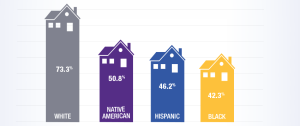Dedrick Asante-Muhammad, Esha Kamra & Connor Sanchez
Over the last two years, there has been much discussion of a national “reckoning” on race. There can be no complete reckoning without strong analysis and substantive action to address the economic marginalization of Native Americans in 21st century America.
Through years of intentional governmental policies that took away their lands and resources, American Indians have been separated from the wealth and assets that were rightfully theirs. Today, we see a consistent lack of information on Native Americans and their socioeconomic issues.
Our organization, the National Community Reinvestment Coalition, recently released a Native American Racial Wealth Divide Snapshot that examines data on social economic indicators like homeownership, poverty rate, and education attainment for Native Americans.

Source: National Community Reinvestment Coalition.
According to the U.S. Census Bureau, the homeownership rate for Native Americans in 2017 was at 50.8 percent, which is higher than for Black and Latino populations, but is still substantially lower than the non-Hispanic white homeownership rate of 72.3 percent.
This 2017 Native American homeownership rate was one of the lowest since the enactment of the Indian Home Loan Guarantee Program of the Housing and Community Development Act in 1992. That Act enables Native Americans to purchase homes with extremely low down payments and covers the lender in full in the event of a foreclosure.
Prior to its passage, according to the 1990 Census, Native American homeownership was 47.2 percent. In 2005 and 2006, Native Americans experienced a record-high 58.2 percent homeownership rate, but by 2016, this has decreased to a low of 47.6 percent. While the Indian Home Loan Guarantee Program apparently has provided a boost to Native American homeownership, there is still much work to do to advance homeownership rates.
In several social economic indicators, Native Americans’ economic marginalization is similar to that of African Americans. Based on the 2015-2019 American Community Survey for the American Indian and Alaska Native population, the median household income was $43,825 – slightly higher than the median income of African American households, which was $41,935.
White household income was about $25,000 higher than African American and Native American income, at $68,785 during this time period. In 2019, African Americans and Native Americans both had an unemployment rate of 6.1 percent. In terms of the poverty rate and educational attainment, Native Americans have the worst numbers of the major racial/ethnic categories, with a poverty rate of 25.4 percent and only 15 percent of Native Americans with a bachelor’s degree or higher.
Addressing the racial wealth divide for Native Americans will require a radical shift of investment and policies of today, yesterday and tomorrow. As the previously-cited data shows, our country is still on the wrong path in addressing racial economic inequality. An important step in this change of direction is to have clear analysis and commitment to addressing the racial economic disparities that are at the heart of the founding of the nation and still run through its veins in the 21st century. A fundamental part of this change is collecting stronger data on the Native American population and a greater focus on addressing our nation’s first peoples economic challenges.
No comments:
Post a Comment